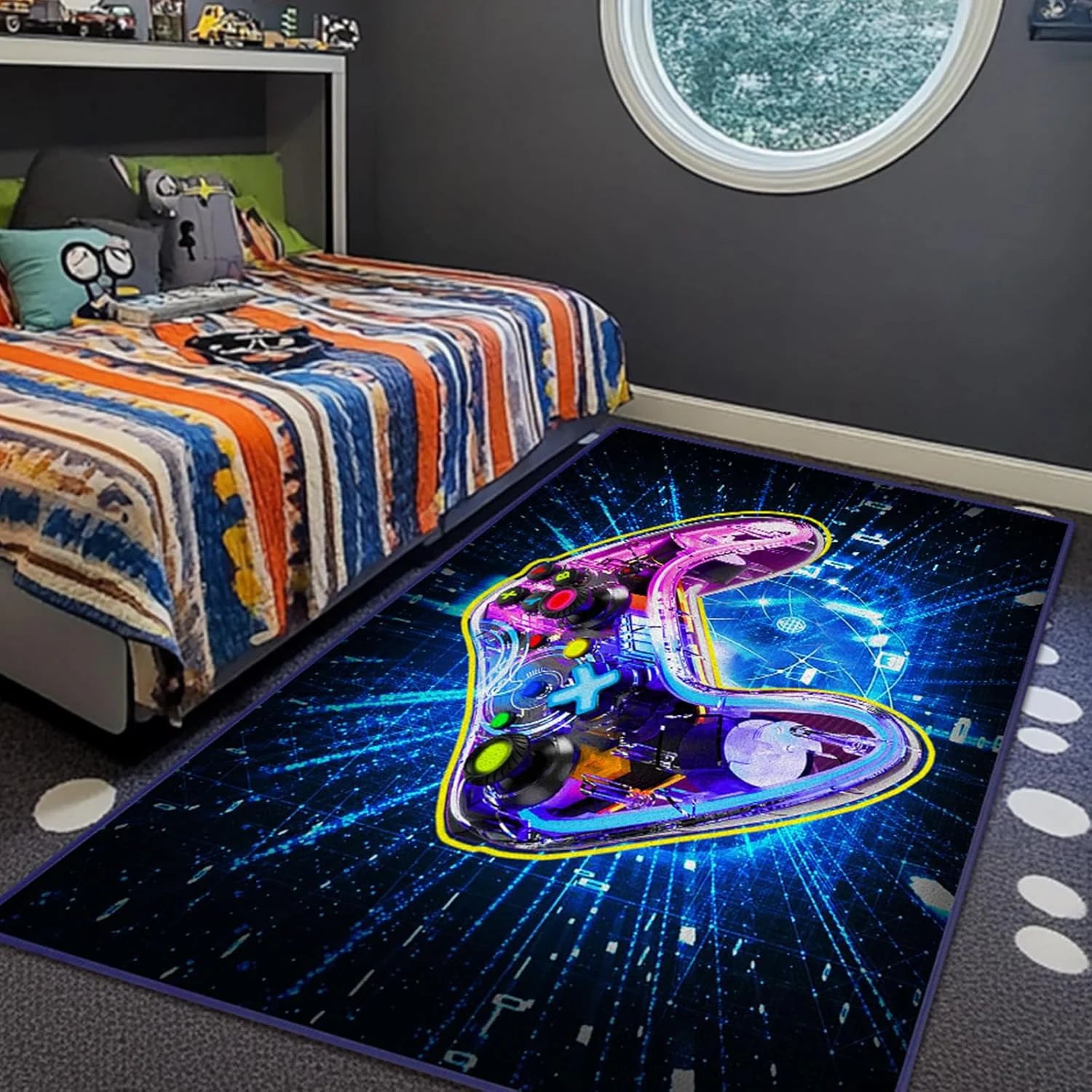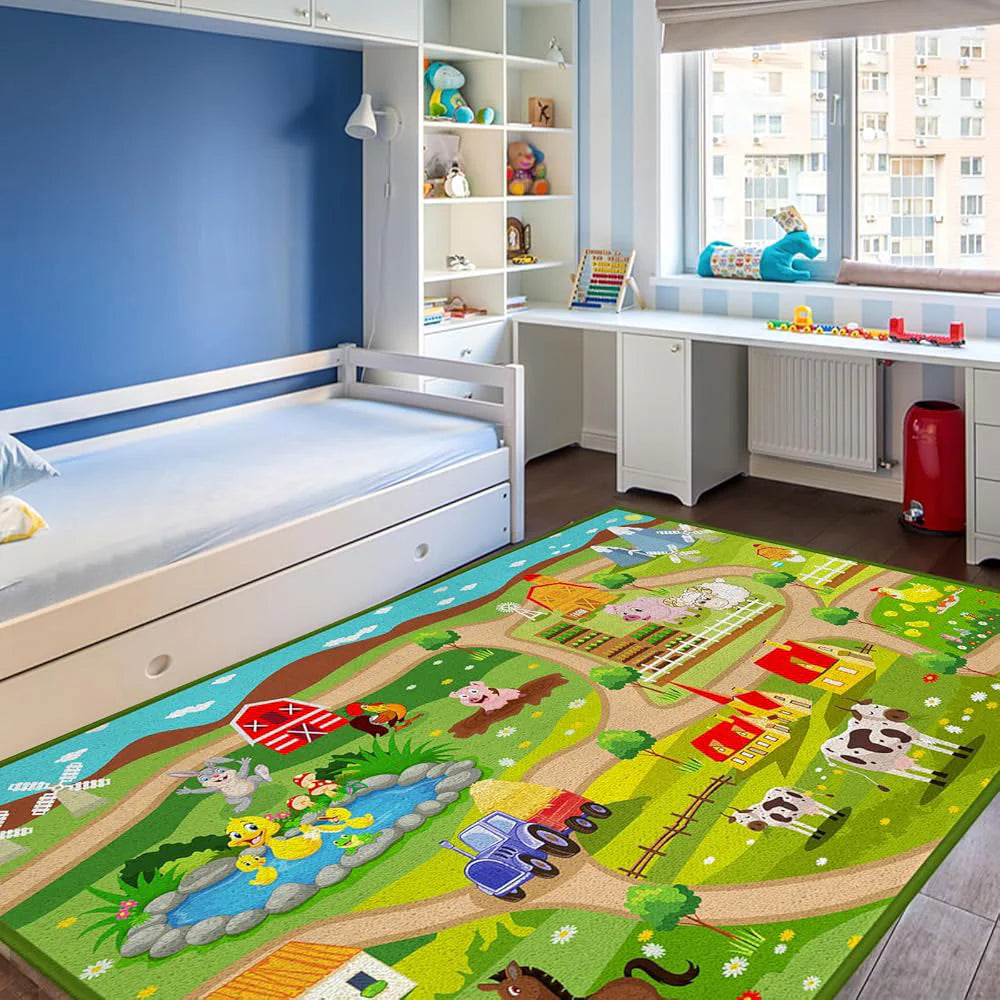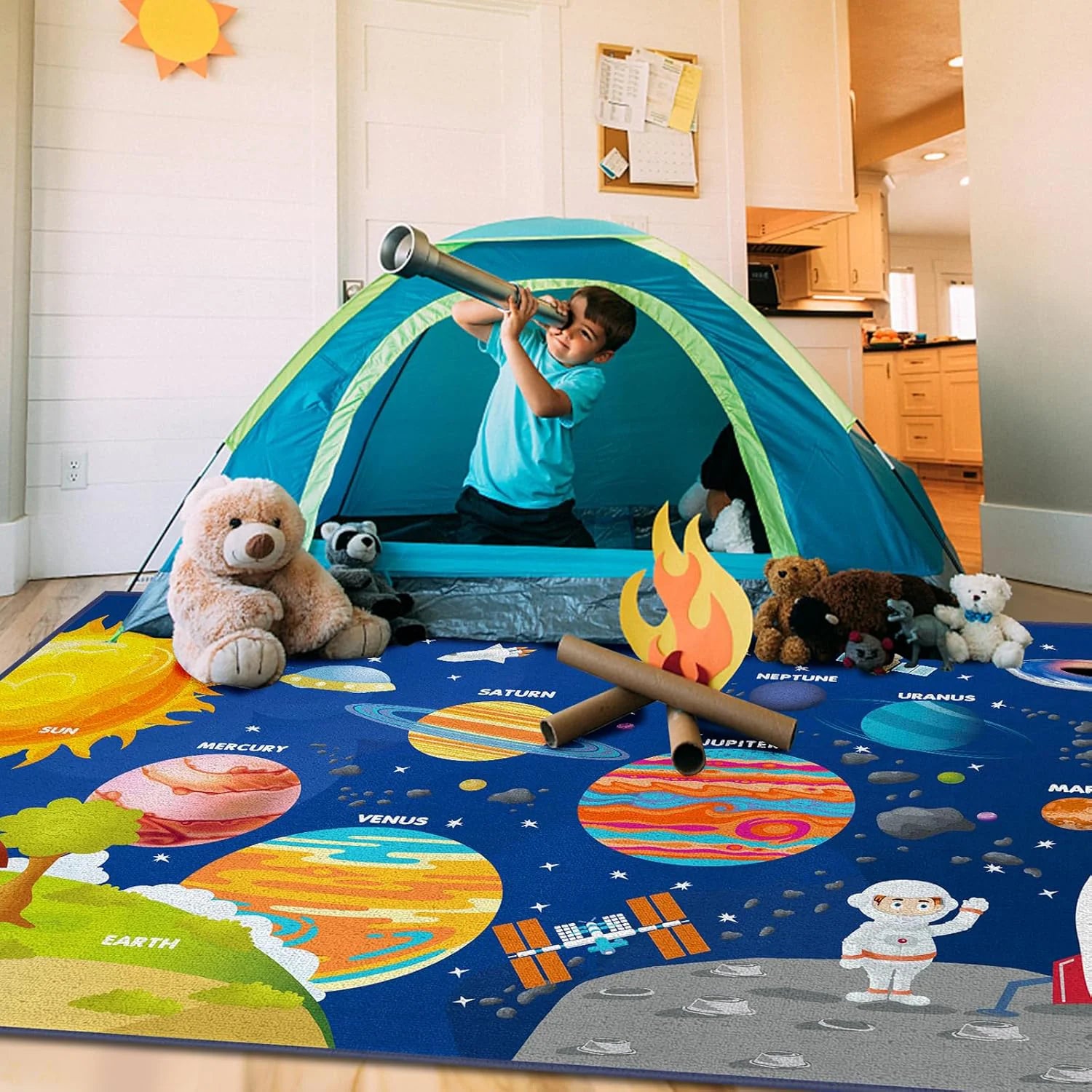Creating a safe, nurturing environment for children involves more than just choosing the right furniture—it requires strategic thinking about every element in their space, including rug placement. With 59% of tip-over injuries involving children under 18 years of age and humidity-related health concerns on the rise, understanding proper rug positioning has never been more critical.
The Hidden Dangers: Areas to Completely Avoid
Critical Furniture Hazard Zones
The most dangerous placement mistake parents make is positioning rugs near unstable furniture. In 2019, 11,521 children visited the emergency department for injuries from furniture or TV tip-overs—that's one child every 46 minutes.
High-Risk Furniture Areas:
- Under or Near Tall Dressers - Children ages 2-5 are at highest risk as they climb to reach items
- Around Unsecured Bookcases - Even short furniture can tip when climbed
- Near TV Stands - Especially those not wall-mounted or properly secured
- Adjacent to Storage Units - Particularly those over 27 inches tall per CPSC guidelines
Why This Matters: The U.S. Consumer Product Safety Commission reports that a child is sent to the emergency room every 60 minutes as a result of falling furniture. Rugs can actually encourage climbing by providing comfortable footing and perceived stability.
Moisture-Prone Areas: The Silent Threat
High-humidity zones create perfect breeding grounds for mold, bacteria, and dust mites—all serious health hazards for developing respiratory systems.
Avoid These Moisture Hotspots:
- Near Humidifiers or Vaporizers - Rug fibers such as wool can absorb up to 30% of their weight in water and not even feel wet
- Bathroom Entrances - Steam and splashing create persistent dampness
- Window Areas with Poor Ventilation - Condensation can pool underneath rugs
- Basement or Ground-Level Rooms - Natural moisture seepage is common
Health Impact: Carpets with higher concentrations of dust were more likely to grow mold than those with lower concentrations, and fungi burrowed into the fibers of rugs made from natural materials.
Strategic Safe Zones: Where Rugs Thrive
Central Play Areas with Clear Sight Lines
Position educational rugs in open floor spaces where children can play safely while remaining visible to supervising adults. Our rugs are designed to spark creativity, motor skills, and teamwork with toddlers practicing balance and color recognition while older kids invent stories and solve puzzle challenges.
Optimal Placement Criteria:
- Minimum 3 feet from any wall-mounted furniture
- Away from climbing temptations like shelves or tall storage
- In well-ventilated areas with good air circulation
- Where natural light prevents moisture buildup
Bedroom Centers with Smart Boundaries
Your kid's rug should be at least two feet (60cm) shorter than the width and length of the room. This spacing prevents rugs from encouraging dangerous furniture interaction while maximizing safe play space.
Professional Sizing Guidelines:
- Small Rooms (8x10 feet) - Use 5x7 foot rugs maximum
- Medium Rooms (10x12 feet) - 6x9 or 8x10 foot rugs work well
- Large Rooms (12x15 feet) - Multiple smaller rugs or one 9x12 maximum
Environmental Health Considerations
Humidity Control: The 30-50% Rule
The key to mold control is moisture control, and it's important to dry water-damaged areas and items within 24-48 hours to prevent mold growth. Maintaining proper humidity levels protects both rug longevity and child health.
Humidity Management Strategy:
- Use dehumidifiers in consistently damp rooms
- Ensure adequate ventilation around all rug areas
- Monitor humidity with inexpensive sensors ($10-15)
- Rotate rugs seasonally to prevent moisture accumulation
Good humidity is between 35 and 50 percent, and if the range is below or above this, the air can make your child cough and have a hard time breathing.
Air Quality Protection
Poor air circulation around rugs can concentrate allergens and pollutants that particularly affect children's developing respiratory systems.
Ventilation Best Practices:
- Leave 6-inch gaps between rugs and walls for airflow
- Use fans to promote circulation in rug areas
- Choose hypoallergenic materials - Our rugs are hypoallergenic and resist dust mites, mold, and mildew, perfect for kids with allergies or asthma
- Implement weekly vacuuming schedules for dust control
Age-Specific Safety Considerations
Toddlers (Ages 1-3): Maximum Protection Zone
This age group requires the most restrictive placement guidelines due to their developmental climbing phase and exploratory behavior.
Toddler-Safe Placement:
- Central floor areas only - No perimeter placement near climbable surfaces
- Away from any furniture over 24 inches tall
- In rooms with secured or removed tip-over hazards
- Where constant supervision is possible
Preschoolers (Ages 4-6): Expanded Safe Zones
As children develop better motor control and judgment, placement options expand while maintaining core safety principles.
Preschooler Considerations:
- Educational rug placement for alphabet, number, and geography learning
- Define activity zones with strategic rug positioning
- Maintain furniture safety standards with all items properly anchored
- Children's developmental furniture safety becomes increasingly important
School Age (Ages 7+): Mature Placement Options
Older children can safely enjoy rugs in more varied locations with proper safety education and environmental controls.
Advanced Placement Strategies:
- Study area rugs for homework and reading zones
- Social gathering spaces for friends and activities
- Hobby and craft areas with easy-clean rug materials
- Sustainable room organization principles apply
Product-Specific Safety Features
Safety-First Design Elements
When selecting rugs for children's spaces, prioritize products designed with safety as the primary consideration.
Essential Safety Features:
- Slip-Resistant Backing - Weighted bottom increases slip resistance by 80%, making it ideal for high-traffic game rooms or busy classrooms
- Non-Toxic Materials - Made with non-toxic, eco-friendly materials free from PVC, phthalates, and lead with rigorous testing to meet ASTM International and CPSC safety standards
- Easy Maintenance - Easily clean with a regular vacuum cleaner—no special equipment needed
- Durable Construction - Durable nylon fibers resist fading, reinforced edges prevent fraying
Maintenance for Safety
Regular maintenance ensures rugs remain safe throughout their lifespan while preventing health hazards.
Safety Maintenance Schedule:
- Daily: Visual inspection for wear, curling edges, or moisture
- Weekly: Thorough vacuuming and spot cleaning as needed
- Monthly: Humidity level checks and ventilation assessment
- Seasonally: Professional cleaning and placement evaluation
Emergency Response and Risk Mitigation
Furniture Tip-Over Prevention
Even with careful rug placement, comprehensive furniture safety remains essential.
Complete Safety Protocol:
- Anchor all furniture over 30 inches to walls - We supply FREE anti-tip kits for all dressers and bookcases 30" (76cm) and above
- Use corner guards on sharp furniture edges
- Install drawer locks on storage units
- Remove climbing temptations from high surfaces
When Accidents Occur
Even if children seem fine after a tip-over incident, there could be internal bleeding or damage to their organs, so immediately take your child to their pediatrician or the emergency room.
Emergency Response Steps:
- Assess child for injuries - Call 911 if unconscious or visibly hurt
- Document the incident for CPSC reporting
- Evaluate and modify room setup to prevent recurrence
- Consider professional safety consultation for high-risk rooms
Future-Proofing Your Child's Environment
Smart Home Integration
Modern technology offers new tools for maintaining safe rug placement through environmental monitoring.
Technology Solutions:
- Smart humidity sensors with smartphone alerts
- Air quality monitors for allergen detection
- Security cameras for monitoring play area safety
- Smart home child safety systems for comprehensive protection
Sustainable Safety Practices
Environmental responsibility and child safety work hand-in-hand when choosing and placing rugs.
Eco-Safe Strategies:
- Choose renewable materials that don't off-gas harmful chemicals
- Implement energy-efficient ventilation for moisture control
- Use natural humidity control methods like plants and proper insulation
- Plan for rug longevity through quality materials and proper care
Professional Assessment and Consultation
When to Seek Expert Help
Certain situations require professional evaluation to ensure optimal safety.
Professional Consultation Indicators:
- Persistent moisture issues despite ventilation efforts
- Recurring respiratory problems in children
- Complex room layouts with multiple safety challenges
- Special needs considerations requiring adaptive safety measures
Building a Safety-First Mindset
Creating truly safe environments requires ongoing education and adaptation as children grow and environments change.
Long-Term Safety Strategy:
- Regular safety audits of all room elements
- Age-appropriate safety education for children
- Stay current with safety standards and product recalls
- Build community knowledge by sharing safety experiences
Conclusion: Creating Truly Safe Spaces
Strategic rug placement involves far more than aesthetics—it's a critical component of comprehensive child safety planning. By avoiding high-risk areas near unstable furniture and moisture-prone zones while prioritizing proper ventilation and age-appropriate positioning, parents can create environments where children thrive safely.
Key Safety Takeaways:
- Furniture proximity is the primary safety concern requiring 3-foot minimum clearances
- Moisture control prevents serious health hazards through proper humidity management
- Age-appropriate placement evolves as children develop motor skills and judgment
- Quality safety features in rug design provide fundamental protection
Remember, the safest rug is one that enhances your child's development while eliminating potential hazards through thoughtful placement and ongoing maintenance.
Related Safety Resources:
- American Academy of Pediatrics Safety Guidelines - Comprehensive child safety recommendations
- EPA Moisture Control Guidelines - Official humidity and mold prevention guidance
- Consumer Product Safety Commission - Latest furniture safety standards and recall information




Leave a comment
This site is protected by hCaptcha and the hCaptcha Privacy Policy and Terms of Service apply.